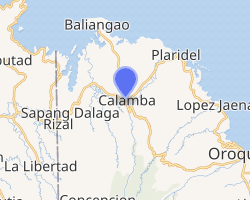Calamba, Misamis Occidental
Calamba, officially the Municipality of Calamba, is a 4th class municipality in the province of Misamis Occidental, Philippines. According to the 2015 census, it has a population of 21,676 people.[3]
Calamba | |
|---|---|
| Municipality of Calamba | |
 Seal | |
 Map of Misamis Occidental with Calamba highlighted | |
OpenStreetMap 
| |
.svg.png) Calamba Location within the Philippines | |
| Coordinates: 8°33′30″N 123°38′30″E | |
| Country | |
| Region | Northern Mindanao (Region X) |
| Province | Misamis Occidental |
| District | 1st district of Misamis Occidental |
| Founded | February 14, 1948 |
| Barangays | 19 (see Barangays) |
| Government | |
| • Type | Sangguniang Bayan |
| • Mayor | Ezel T. Villanueva |
| • Vice Mayor | Antonio N. Lawas Sr. |
| • Congressman | Diego C. Ty |
| • Electorate | 15,522 voters (2019) |
| Area | |
| • Total | 104.64 km2 (40.40 sq mi) |
| Elevation | 116.3 m (381.6 ft) |
| Population (2015 census)[3] | |
| • Total | 21,676 |
| • Density | 210/km2 (540/sq mi) |
| • Households | 4,937 |
| Economy | |
| • Income class | 4th municipal income class |
| • Poverty incidence | 26.18% (2015)[4] |
| • Revenue (₱) | 90,693,008.99 (2016) |
| Time zone | UTC+8 (PST) |
| ZIP code | 7210 |
| PSGC | |
| IDD : area code | +63 (0)88 |
| Climate type | tropical climate |
| Native languages | Subanon language Cebuano Tagalog |
| Website | www |
Barangays
Calamba is politically subdivided into 19 barangays.
- Bonifacio
- Bunawan
- Calaran
- Dapacan Alto
- Dapacan Bajo
- Langub
- Libertad
- Magcamiguing
- Mamalad
- Mauswagon
- Northern Poblacion
- Salvador
- San Isidro
- Siloy
- Singalat
- Solinog
- Southwestern Poblacion
- Sulipat
- Don Bernardo Neri Poblacion
Climate
| Climate data for Calamba, Misamis Occidental | |||||||||||||
|---|---|---|---|---|---|---|---|---|---|---|---|---|---|
| Month | Jan | Feb | Mar | Apr | May | Jun | Jul | Aug | Sep | Oct | Nov | Dec | Year |
| Average high °C (°F) | 27 (81) |
27 (81) |
29 (84) |
30 (86) |
30 (86) |
29 (84) |
29 (84) |
29 (84) |
30 (86) |
29 (84) |
29 (84) |
28 (82) |
29 (84) |
| Average low °C (°F) | 22 (72) |
22 (72) |
22 (72) |
23 (73) |
24 (75) |
24 (75) |
23 (73) |
23 (73) |
23 (73) |
23 (73) |
23 (73) |
22 (72) |
23 (73) |
| Average precipitation mm (inches) | 69 (2.7) |
44 (1.7) |
37 (1.5) |
29 (1.1) |
87 (3.4) |
137 (5.4) |
131 (5.2) |
141 (5.6) |
143 (5.6) |
134 (5.3) |
68 (2.7) |
53 (2.1) |
1,073 (42.3) |
| Average rainy days | 9.9 | 7.6 | 7.4 | 8.1 | 21.6 | 26.5 | 26.4 | 26.6 | 25.8 | 24.3 | 15.1 | 10.4 | 209.7 |
| Source: Meteoblue (Use with caution: this is modeled/calculated data, not measured locally.) [5] | |||||||||||||
Demographics
| Population census of Calamba | ||||||||||||||||||||||||||||||||||||||||
|---|---|---|---|---|---|---|---|---|---|---|---|---|---|---|---|---|---|---|---|---|---|---|---|---|---|---|---|---|---|---|---|---|---|---|---|---|---|---|---|---|
|
| |||||||||||||||||||||||||||||||||||||||
| Source: Philippine Statistics Authority[3][6][7][8] | ||||||||||||||||||||||||||||||||||||||||
In the 2015 census, the population of Calamba, Misamis Occidental, was 21,676 people,[3] with a density of 210 inhabitants per square kilometre or 540 inhabitants per square mile.
Schools
The Liberation Institute, Calamba
- Calamba Central School
- Calamba National Comprehensive High School
- Liberation Institute
- Sacred Heart College
- CCIT or College of Communication, Information & Technology
- MCC
- Jansen Computer Institute
References
- "Municipality". Quezon City, Philippines: Department of the Interior and Local Government. Retrieved 31 May 2013.
- "Province: Misamis Occidental". PSGC Interactive. Quezon City, Philippines: Philippine Statistics Authority. Retrieved 12 November 2016.
- Census of Population (2015). "Region X (Northern Mindanao)". Total Population by Province, City, Municipality and Barangay. PSA. Retrieved 20 June 2016.
- "PSA releases the 2015 Municipal and City Level Poverty Estimates". Quezon City, Philippines. Retrieved 12 October 2019.
- "Calamba: Average Temperatures and Rainfall". Meteoblue. Retrieved 29 April 2020.
- Census of Population and Housing (2010). "Region X (Northern Mindanao)". Total Population by Province, City, Municipality and Barangay. NSO. Retrieved 29 June 2016.
- Censuses of Population (1903–2007). "Region X (Northern Mindanao)". Table 1. Population Enumerated in Various Censuses by Province/Highly Urbanized City: 1903 to 2007. NSO.
- "Province of Misamis Occidental". Municipality Population Data. Local Water Utilities Administration Research Division. Retrieved 17 December 2016.
External links
This article is issued from Wikipedia. The text is licensed under Creative Commons - Attribution - Sharealike. Additional terms may apply for the media files.